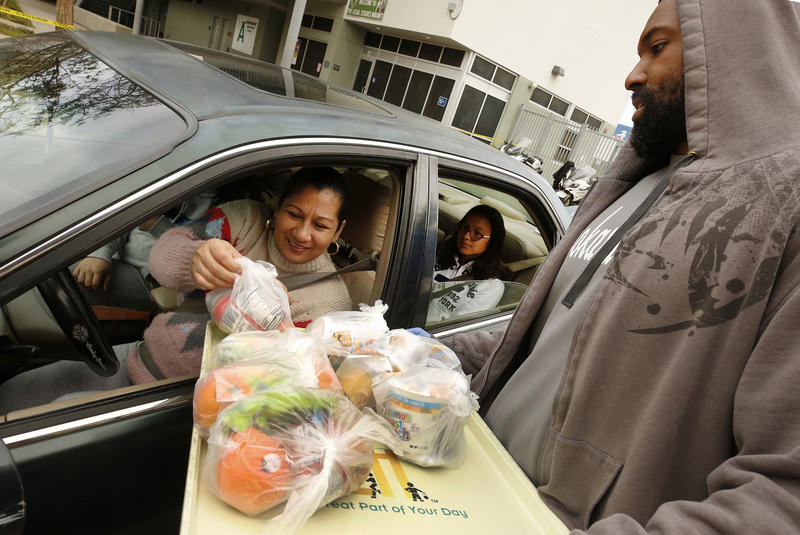
Black teachers: How to recruit them and make them stay

Lessons in higher education: What California can learn

Keeping California public university options open

Superintendents: Well-paid and walking away

The debt to degree connection

College in prison: How earning a degree can lead to a new life

Pandemic-era policies like eviction moratoriums, the expanded child tax credit, increased food stamp benefits and free school meals helped decrease hardship for families with young children.
Yet when many of those programs were discontinued, these same families saw an increase in hardship.
These are the latest findings from the RAPID survey, a national survey of parents and guardians with children from birth to 5 years old, conducted by researchers at the Stanford Center for Early Childhood. The group has collected answers to survey questions from 14,357 parents of young children nationwide every month between April 2020 and April 2023. Questions asked included whether parents could pay for food, child care and housing.
“The combination, where you have higher prices to pay for basic things like food and gas and you have these tax credits and other payments that went away, that’s where you see people really falling over the edge,” said Philip Fisher, director of the Stanford Center on Early Childhood.

Courtesy of RAPID
A graph from the RAPID survey showing families reporting hardship over time.
Fisher said researchers found what he calls a “chain reaction to hardship” — when parents can’t afford to pay for child care or food in a given week, that causes them higher levels of distress, and then their children begin struggling.
“If we’re concerned about the well-being of kids, we should be concerned about the well-being of adults in the lives of children,” Fisher said. “Policies that support families’ economic stability and sufficiency are critical for supporting children’s early learning, and when we see those policies go away, we’re placing additional burden on the education system to make up for the ground that’s lost for families having this kind of hardship.”
Advocates for families with young children in California said that though the survey is nationwide, California policymakers can learn from it and put in place more policies to help children from an early age.
“Families with infants and toddlers have largely been told, ‘You’re on your own,’” said Stacy Lee, chief learning officer and senior managing director for early childhood at the advocacy organization Children Now. “The more we can do earlier on to support families, we know that that results in good outcomes for our children.”
Lee said she applauds California legislators and the governor for funding or expanding several programs in this year’s budget that will help low-income families, such as increasing subsidies for child care and capping the amount families have to pay for subsidized child care to 1% of their income. In addition, she mentioned that a budgeted increase for CalWORKs, a public assistance program that provides cash aid to low-income families with children, and CalFresh, the state’s food stamp program, and expanding free school meals to summertime will all help the lowest-income families.
“But there are still a large number of families out there who may not fit that criteria and will see continuing challenges to navigate life in the coming year,” Lee said.
Lee said programs that help alleviate poverty for families have a clear effect on children’s education.
“We all know that it makes it harder for children to concentrate at school if they’re hungry,” she said.
“I believe that this data makes clear that poverty is a policy choice,” said Mayra Alvarez, president of The Children’s Partnership, a nonprofit children’s advocacy organization based in Los Angeles. “During the pandemic, rules were put in place to make accessing services and programs easier for families. We have to ask ourselves, why can’t it always be this way?”
Alvarez said it is urgent for California to do something to help young children keep health insurance now that pandemic-era requirements to keep continuous Medi-Cal coverage have ended. She said an estimated 2 million to 3 million Californians could lose coverage, including between 800,000 and 1 million children. A law passed last year will allow children to keep Medi-Cal coverage from birth to age 5, but it won’t be implemented until 2025.
“This delay in implementation places thousands of children at risk of losing coverage unnecessarily, and it’s why we, alongside many partners, are asking the administration to move forward with implementation as quickly as possible,” Alvarez said.

Panelists discussed dual admission as a solution for easing the longstanding challenges in California’s transfer system.

A grassroots campaign recalled two members of the Orange Unified School District in an election that cost more than half a million dollars.

Legislation that would remove one of the last tests teachers are required to take to earn a credential in California passed the Senate Education Committee.

Part-time instructors, many who work for decades off the tenure track and at a lower pay rate, have been called “apprentices to nowhere.”
Comments (2)
Comments Policy
We welcome your comments. All comments are moderated for civility, relevance and other considerations. Click here for EdSource's Comments Policy.
Matt 9 months ago9 months ago
Poverty-stricken families suffered when temporary government handouts dried up? You don’t say! In other news … water is wet!
Greg L 9 months ago9 months ago
The lack of critical questions and alternative perspectives in this story is disappointing, if typical. Closer to stenography than journalism